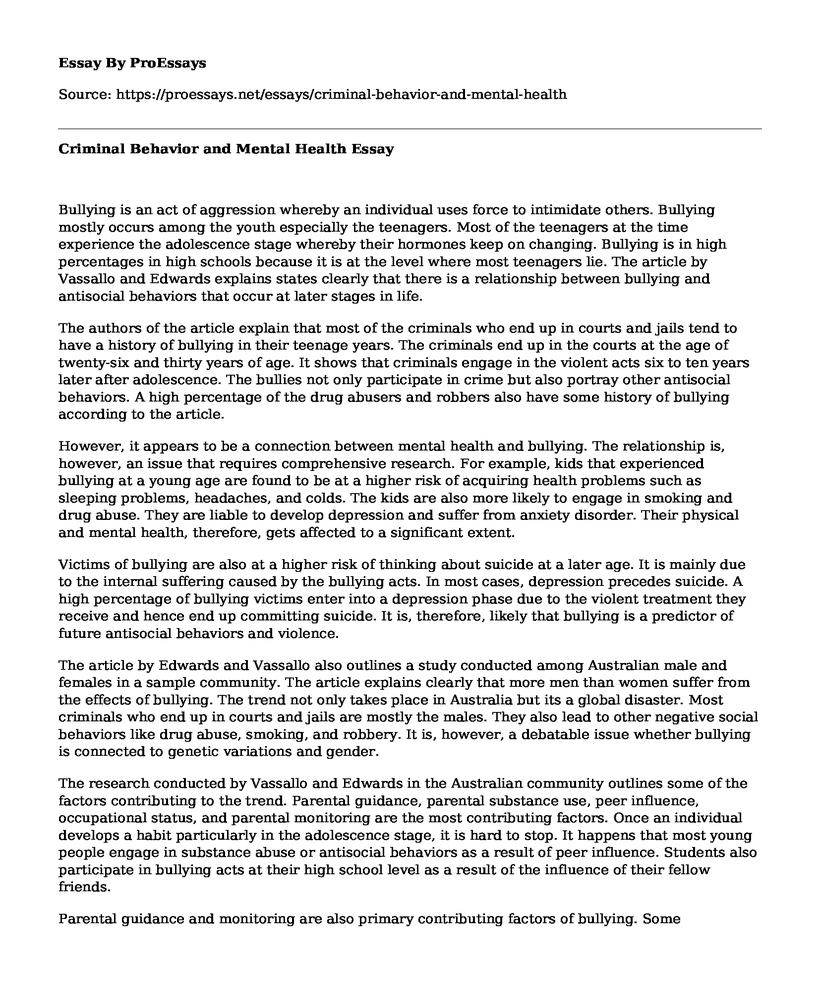Bullying is an act of aggression whereby an individual uses force to intimidate others. Bullying mostly occurs among the youth especially the teenagers. Most of the teenagers at the time experience the adolescence stage whereby their hormones keep on changing. Bullying is in high percentages in high schools because it is at the level where most teenagers lie. The article by Vassallo and Edwards explains states clearly that there is a relationship between bullying and antisocial behaviors that occur at later stages in life.
The authors of the article explain that most of the criminals who end up in courts and jails tend to have a history of bullying in their teenage years. The criminals end up in the courts at the age of twenty-six and thirty years of age. It shows that criminals engage in the violent acts six to ten years later after adolescence. The bullies not only participate in crime but also portray other antisocial behaviors. A high percentage of the drug abusers and robbers also have some history of bullying according to the article.
However, it appears to be a connection between mental health and bullying. The relationship is, however, an issue that requires comprehensive research. For example, kids that experienced bullying at a young age are found to be at a higher risk of acquiring health problems such as sleeping problems, headaches, and colds. The kids are also more likely to engage in smoking and drug abuse. They are liable to develop depression and suffer from anxiety disorder. Their physical and mental health, therefore, gets affected to a significant extent.
Victims of bullying are also at a higher risk of thinking about suicide at a later age. It is mainly due to the internal suffering caused by the bullying acts. In most cases, depression precedes suicide. A high percentage of bullying victims enter into a depression phase due to the violent treatment they receive and hence end up committing suicide. It is, therefore, likely that bullying is a predictor of future antisocial behaviors and violence.
The article by Edwards and Vassallo also outlines a study conducted among Australian male and females in a sample community. The article explains clearly that more men than women suffer from the effects of bullying. The trend not only takes place in Australia but its a global disaster. Most criminals who end up in courts and jails are mostly the males. They also lead to other negative social behaviors like drug abuse, smoking, and robbery. It is, however, a debatable issue whether bullying is connected to genetic variations and gender.
The research conducted by Vassallo and Edwards in the Australian community outlines some of the factors contributing to the trend. Parental guidance, parental substance use, peer influence, occupational status, and parental monitoring are the most contributing factors. Once an individual develops a habit particularly in the adolescence stage, it is hard to stop. It happens that most young people engage in substance abuse or antisocial behaviors as a result of peer influence. Students also participate in bullying acts at their high school level as a result of the influence of their fellow friends.
Parental guidance and monitoring are also primary contributing factors of bullying. Some adolescents copy the habits of their parents. They reason that some of the habits are acceptable since they observe their parents engaging in them. For example, most young people copy smoking and drug abuse from their parents. There are also numerous cases of parents who are bullies. Children born in such marriages tend to end up in bullying acts at their later ages. Others also tend to suffer from the effects of such marriages and end up in depression that may lead to suicide.
Young people require advice and monitoring during their adolescence stage. Failure to correct a bullying habit in an adolescent male or female will result in the individual engaging in other social crimes. The article by Edward points to antisocial crimes and violence as the result of bullying acts in the earlier age. A large portion of adolescent bullies who lack parental guidance find it difficult to stop the habit.
Victims of bullying are more likely to exhibit external behaviors such as cruelty. Bullying is a very intimidating and irritating behavior, especially to the victim. The victims will, therefore, tend to find their way of dealing with the effects of bullying. Cruelty is one of the post effects of bullying. Most of the bullying acts are cruel in nature hence, the victims tend to copy the habit too. They become cruel to everyone they come across whether parents or members of the society.
Conclusion
Edward and Vassallos article points out to a possible relationship between bullying among the adolescent teenagers and antisocial behaviors/crime at later ages. The research conducted by the authors shows clear statistics of a possible link between the two. Bullying is an action with adverse impacts on the bully, the victim, and the society as a whole. It is, therefore, time that the society joined hands in stopping the vice.
Cite this page
Criminal Behavior and Mental Health. (2021, Mar 11). Retrieved from https://proessays.net/essays/criminal-behavior-and-mental-health
If you are the original author of this essay and no longer wish to have it published on the ProEssays website, please click below to request its removal:
- Essay Example on Communities and Mental Health
- Research Paper on Gun Control Issues
- Summary of Read-Only Participants: A Case for Student Communication in Online Classes
- Essay Example on Tourists and Stereotypes: Exploring the Impact on Travel
- Essay Example on Vygotsky's Theory: Social Interaction & Cognitive Development
- Personality Theory: Unlocking Workplace Behavior & its Benefits to HR - Essay Sample
- Essay on Court Procedures: Determining Admissible Evidence & Privilege Communication







